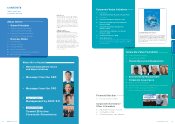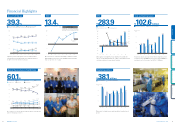Omron 2015 Annual Report Download - page 18
Download and view the complete annual report
Please find page 18 of the 2015 Omron annual report below. You can navigate through the pages in the report by either clicking on the pages listed below, or by using the keyword search tool below to find specific information within the annual report.
■
Portfolio Management Categories
■
Down-Top ROIC Tree
KPI Drivers
Sales in Focus Industries / Areas
Sales of New / Focus Products
Selling Price Control
Variable Costs Reduction, Value %
Defect Costs %
Per-head Production #
Automation %
(headcount reduction)
Inventory Turnover Months
Slow-Moving Inventory Months
Credits & Debts Months
Facilities Turnover
(1/N Automation Ratio)
Labor Costs-Sales %
Added-
Value %
Fixed
Manufacturing
Costs %
Working
Capital
Turnover
Fixed Assets
Turnover
SG&A %
R&D %
Invested
Capital
Turnover
Gross Profit
Margin
ROS
ROIC
ROIC (%)
B
Expecting
Growth
S
Investment
C
Profit
Restructuring
A
Examining
Regrowth
Sales Growth (%)
Special Feature 1: Management by ROIC 2.0
The following chart presents the ROIC formu-
la and our own interpretation. The simple logic
is this: Add the
Necessary Management Re-
sources (N)
and generate greater levels of
Value to Customers (V)
, while reducing
Loss-Making Management Resources (L)
.
Incidentally, we define loss-making resources
as those that involve
Muri, Muda, Mura
(waste,
unevenness, overburden).
sizing equipment, we limited investment, floor space
requirements, and the energy required to run the
machinery. Compared to an
“all-or-nothing”
approach to adding production capacity, we
avoided waste in terms of low utilization / turnover.
In other words, we successfully reduced our
Loss-Making Resources (L)
. At the same time, we
have enough capacity to protect against order
opportunity loss when demand rises further. From
the perspective of the customer, our adding
capacity in minimum units to meet demand in-
creases their order flexibility while reducing excess
inventory. This is a definite increase in
Value to
Customers (V)
.
This has proven to be a much more efficient
approach to investing in capital equipment for
the Electronic and Mechanical Components
Business. As one example, we have reduced
floor space requirements to one-fifth of the
space needed just 10 years ago. We are using
this 1/n reduction factor in a number of other
areas as well, including other types of capital
equipment, manufacturing, and energy usage.
Our Electronic and Mechanical Components
Business is a good case study to illustrate
ROIC Reverse Tree Management. This is a
business that involves significant capital invest-
ment in production equipment, which means
that production facilities turnover is an import-
ant performance indicator.
Production volume for relays and other me-
chanical components varies according to sea-
sonality and demand in the home electronics
market. In the past, we have had trouble match-
ing equipment investment with this changing
demand, adding equipment too late, thereby
decreasing our return on facilities ratios.
This business requires that we minimize wast-
ed investment in equipment, while responding
correctly to changes in demand. Accordingly,
we have focused on downsizing our production
equipment, or in other words, reducing produc-
tion equipment by a factor of 1/n.
Our first concern was to reduce
Necessary Man-
agement Resources (N)
, relay or switch production
equipment in this case, to the smallest unit possi-
ble to still meet the increase in demand. By down-
day-to-day duties. ROIC is a relatively easy
concept for those in our strategic, accounting,
and finance departments to relate to. For our
employees in sales or development, this
financial management concept is both unfa-
miliar and difficult to internalize. Understand-
ing this, we have decided to provide a qualita-
tive interpretation that tells the story of ROIC
in more relatable terms. This is
Management
by ROIC
2
.
0
.
ROIC Reverse Tree Formula and Interpreted Formula
■
Interpreted Formula
■
Omron’s ROIC Reverse Tree Formula
ROIC≒Necessary Management
Resources (N)
Value to Customers (Stakeholders) (V)
(Goods, Money, Time) Muri, Muda, Mura
(waste, unevenness, overburden)
Loss-Making Management
Resources (L)
+
ROIC= ×
Net Profit
Sales
Sales
Invested Capital
(Working Capital + Fixed Assets)
tics. We began Management by ROIC in earnest
three years ago, making significant ROIC gains
since that time. I am confident that, at this
point, every member of management is at least
aware of the concept of ROIC and its impor-
tance as a performance indicator at Omron.
On the other hand, I am sure there are many
who have yet to link ROIC with their own
1.Why Management by ROIC 2.0 ?
At Omron Corporation, Management by ROIC
consists of two main components: Down-Top
ROIC Tree and Portfolio Management. Return on
invested capital is the most important indicator we
use to measure progress in our business plan.
ROIC is an excellent measure for fairly as-
sessing business performance across a number
of businesses that have different characteris-
Management
by ROIC 2.0
Special
Feature 1
Takayoshi Oue
Executive Officer
Senior General Manager,
Global Finance and Accounting HQ
2. Case Study
32 OMRON Corporation Integrated Report 2015 33
About Omron Where We’re Headed Corporate Value Initiatives Corporate Value Foundation Financial Section
























